class: center, middle, inverse, title-slide # Character judgments ## Week 4 - Moral Psychology --- # Week 4 This week we will be discussing how we judge the moral character of others and ascribe blame and praise to their actions .highlight-blue[In week 4:] - **Which traits do we automatically evaluate in strangers?** - **How do evaluate if someone is a good person?** - Under what conditions is someone absolved from blame for their actions? - When is someone deserving of praise for their actions? --- # Activity .right-column-med[ 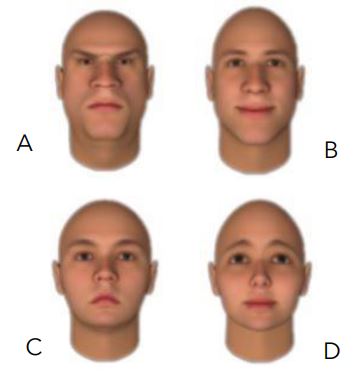] .left-column-med[**Instructions**: Answer the following questions. Rely on your "gut feeling." There are no right or wrong answers. .smaller[ - Which one of these people would you hire to work as your assistant? - Which one of these people would you hire to babysit your kids? - Which one of these people would you vote for as president? - Who looks the most trustworthy?]] --- # Judging traits .footnote[Todorev et al. (2008)] .left-column-med[#### Method In a repeated measures design, participants were shown computer generated faces and asked to rate them on different traits] .right-column-med[ 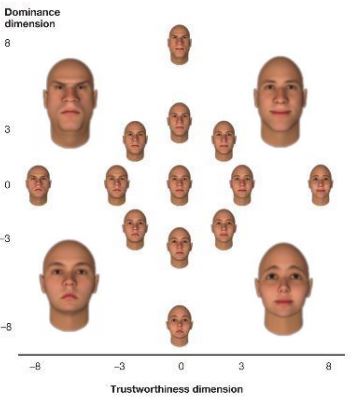] --- # Judging traits .footnote[Todorev et al. (2008)] .right-column-med[ ] .left-column-med[#### Results The researchers found that people's impressions could be categorized into two dimensions - .highlight-blue[First dimension:] <br>trustworthy to untrustworthy - .highlight-blue[Second dimension:] <br> Dominant to submissive] ??? PCA - the judgments in each component were highly correlated with each other . The first two components explained about 80% of the variance in judgment scores --- # Judging traits .footnote[Todorev et al. (2008)] .left-column-med[] The top left faces were rated as **untrustworthy and dominant** - These faces had hypermasculine features, like a pronounced jaw, small eyes, small forehead, and low eyebrows --- # Judging traits .footnote[Todorev et al. (2008)] .left-column-med[] The bottom right faces were rated as **trustworthy and submissive** - These faces had child-like features, like large round eyes, large foreheads, high eyebrows, and round, small chins --- # Judging traits .footnote[Todorev et al. (2008)] .right-column-small[] .left-column-big[These personality inferences are automatic and they occur **even though there is little evidence that they are accurate** - These quick inferences may even lead us to misjudge the threat of others, such as Ted Bundy, who famously lured women by looking non-threatening] --- # Judging traits .footnote[Todorev et al. (2008)] .right-column-small[] .left-column-big[- This study also illuminates how *important* moral character judgments are to first impressions; the goal of the first impression seems to be to determine if the other individual will be .highlight-blue[capable of] and .highlight-blue[motivated to] harm you] --- # Judging moral character .right-column-small[] .left-column-big[Perhaps you do not want to be fooled by appearance. How would you know if Ted Bundy is a good person or not? You can observe him. What does Ted Bundy *do*? ] --- # Judging moral character .right-column-small[] .left-column-big[ > .smaller[On Saturday mornings, Molly and Ted would watch cartoons together and let me sleep in. Their favorite was Dudley Doright and the Mounties. Dudley had a girlfriend named Nell whom he saved from villains who routinely tied her to railroad tracks. Ted could mimic Dudley perfectly, and he would call Molly “Nell.” Together, “Dudley and Nell” would fix breakfast and bring it to me in bed." .right[-Elizabeth Kendall, ex-girlfriend <br> *The Phantom Prince, My Life with Ted Bundy*]]] --- # Judging moral character > .smaller[A few of the horrendous facts include: He abducted and killed two women in one day and then took me out to dinner that evening. He raped and murdered women and then slept with me. He took my visiting family out for a fun evening of pizza. He then excused himself, went to a bar in South Seattle, found a young woman, and murdered her. The next day he was his charming self at a family event. One day when he was driving to Utah to go to law school, he called from Nampa, Idaho, to tell me he loved me. I learned later that he abducted a young woman that day and murdered her. .right[-Elizabeth Kendall, ex-girlfriend <br> *The Phantom Prince, My Life with Ted Bundy*]] -- .highlight-blue[Behavior is not a perfect indicator of character because bad people can do good things (And good people can do bad things)] --- # Activity .footnote[Helzer & Critcher (2018)] **Observed behavior**: a man walks past a homeless man and the homeless man asks for $10. Which of these people would you consider the most *moral*? Which of these people would you consider the most *immoral*? .pull-left[<u>Person 1</u> <br> He feels sympathy for the homeless man so he gives him $10 <u> Person 3 </u><br> He feels sympathy for the man but isn't carrying any money] .pull-right[<u>Person 2</u> <br>He gives $10 because he is walking with his boss who he is trying to impress <br> <u> Person 4 </u> <br> He feels giddy that there was a man suffering, calls him a loser, and walks away] --- # Judging moral character Behavior is sometimes but not always informative of whether or not someone is a good person - We need to consider intentions, circumstances, and most importantly, their <u>**moral-cognitive machinery**</u> --- # Moral-cognitive machinery .footnote[Helzer & Critcher (2018)] We can determine if a car's *machinery* works by testing it to see if inputs cause appropriate outputs, i.e., when we do something to the car, it should react in the way that we would expect a functioning car to act - When you turn the key, you should hear the engine start. - When you press on the gas pedal, the car should move forward. - When you press on the volume button, music should play. .right-column-med[] --- # Moral-cognitive machinery .footnote[Helzer & Critcher (2018)] Similarly, we can determine if someone's *moral-cognitive* machinery works by testing it to see if inputs cause appropriate outputs - When a person is suffering, a person should feel compassion and a desire to help. - When someone cheats on their partner, they should feel guilty and compelled to stop or be honest about their actions. --- # Moral-cognitive machinery .footnote[Helzer & Critcher (2018)] Someone with properly functioning *moral-cognitive machinery* will... - Attend to relevant cues - Appropriately process the cues - Arrive at an appropriate moral decision --- # Moral-cognitive machinery .footnote[Helzer & Critcher (2018)] For example, someone with functioning moral-cognitive machinery who walks by and sees someone suffering will.. - Attend to relevant cues - Properly notice and identify that the person is suffering - Appropriately process the cues - Feel sympathy for the person - Arrive at an appropriate moral decision - Do what they can to help --- # Moral-cognitive machinery .footnote[Helzer & Critcher (2018)] <u>Person 1</u> He feels sympathy for the homeless man so he gives him $10 (functioning moral-cognitive machinery with means to help) <u>Person 2</u> He gives $10 because he is walking with his boss who he is trying to impress (possibly broken moral-cognitive machinery) <u> Person 3 </u> He feels sympathy for the man but isn't carrying any money (functioning moral-cognitive machinery without means to help) <u> Person 4 </u> He feels giddy that there was a man suffering, calls him a loser, and walks away (definitely broken moral-cognitive machinery) --- # Moral-cognitive machinery .footnote[Helzer & Critcher (2018)] Someone with functioning moral-cognitive machinery will, over time, make good moral decisions (i.e., outputs), given the context (i.e., inputs) - Good people have a *functioning moral-cognitive machinery* and bad people do not - Since bad people have broken machinery, they will consistently do bad things - Thus, we should care more about evaluating a person's machinery than about evaluating their specific behaviors --- # Moral-cognitive machinery .footnote[Helzer & Critcher (2018)] > A runaway trolley is barreling down a set of train tracks. There is unfortunately no conductor to stop the train, which is about to run over and kill five people... > Robert is standing to the side of the track. Next to him is a lever. If he pulls the lever, it will divert the train onto an alternate track .highlight-blue[where it will kill his infant son] instead of the five. Without hesitation, Robert pulls the lever because five people is more than one person. .dq[Is Robert's moral-cognitive machinery working as it should?] --- # Judging machinery .footnote[Critcher et al. (2012)] #### Method Researchers tested whether how quickly people came to a moral decision affected how others perceived their character Participants were randomly assigned to read either a story about quick deciding Justin or slow deciding Nate doing either moral or immoral actions --- # Judging machinery .footnote[Critcher et al. (2012)] ####Immoral condition <center><b>Quick decision</b></center> >.smaller[Justin came across a cash-filled wallet in the parking lot of a local grocery store. *He decided quickly what to do. He pocketed the money and drove off.*] <center><b>Slow decision</b></center> > .smaller[Nate came across a cash-filled wallet in the parking lot of a local grocery store. *After a long and careful deliberation, he decided what to do. He pocketed the money and drove off.*] --- # Judging machinery .footnote[Critcher et al. (2012)] #### Moral condition <center><b>Quick decision</b></center> > .smaller[Justin came across a cash-filled wallet in the parking lot of a local grocery store. *He decided quickly what to do. He returned the wallet to customer service.*] <center><b>Slow decision</b></center> > .smaller[Nate came across a cash-filled wallet in the parking lot of a local grocery store. *After a long and careful deliberation, he decided what to do. He returned the wallet to customer service.*] --- # Judging machinery .footnote[Critcher et al. (2012)] .left-column-med[#### Results - People who returned the money were evaluated more positively than those who stole the money - Quick immoral decisions were seen as more negative than slow immoral decisions, and quick moral decisions were seen as more moral than slow moral decisions] .right-column-med[ 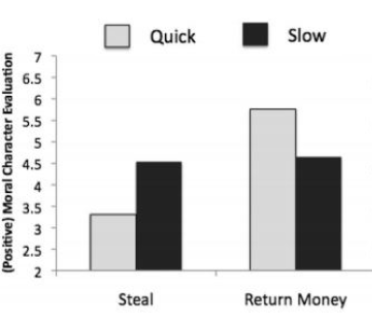] ??? Rate the moral character of Justin and Nate on a scale of 1 = "has entirely bad moral principles" to 7 = "has entirely good moral principles." --- # Judging machinery .footnote[Critcher et al. (2012)] #### Discussion - The decision speed is assumed to reflect how easy the decision was and how confident the individual is in the decision - When people make a decision easily, we tend to think that we are getting information about one's moral-cognitive machinery, rather than the circumstances - This person *automatically* steals (non-functioning machinery) vs. this person *automatically* does not steal (functioning machinery) - When the decision is slow, we can understand less about the underlying machinery because we do not know why the person is conflicted --- # Judging machinery .footnote[Tannenbaum, Uhlmann, & Diermeier (2011)] #### Method The participants read that a manufacturing company was interviewing two candidates for CEO, John and Robert - High salary candidate requested a salary of $2 million per year - Low salary candidate requested a salary of $1 million per year plus a signing bonus (randomly assigned) - $40,000 cash - a $40,000 marble table - a $40,000 marble table engraved with the candidate's portrait --- # Judging machinery .footnote[Tannenbaum, Uhlmann, & Diermeier (2011)] .pull-right[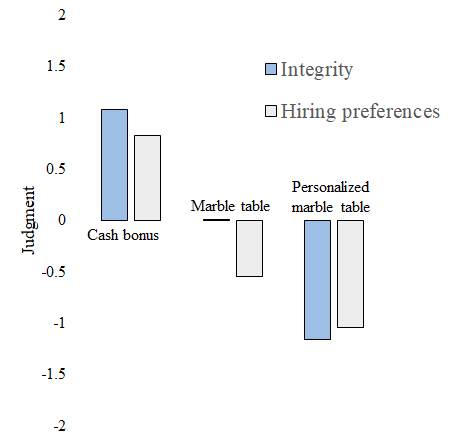] .pull-left[#### Results - People would rather hire the CEO asking for 1 million (+40,000) than the CEO who is asking for 2 million - However, people consider the marble table signing bonus as indicative of *poor moral character* ] --- # Judging machinery .footnote[Tannenbaum, Uhlmann, & Diermeier (2011)] .pull-right[] .pull-left[#### Results - People are willing to pay almost twice as much money to not hire someone asking for a personalized marble table ] ??? Emphasize how marble table and cash bonus are the same... the person could just buy a marble table with their cash bonus --- # Judging machinery Let's return to the trolley problem where Robert quickly decided to be a utilitarian (decide on what is moral by the consequences of the action) and kill his infant son to save the five people on the train Instead of killing his son quickly and nonchalantly, you probably expected him to: - Attend to both his infant son and the 5 people, realizing that he has a profoundly difficult decision to make - Feel immense distress and compassion for his son and the people on the tracks - Regretfully not be able to pull the lever (or if he does, he would show immense remorse) --- # Person-act dissociations **Person-act dissociation:** like the man willing to sacrifice his son for the greater good, moral praiseworthy actions *can* signal negative information about the character of an actor --- # Person-act dissociations .footnote[Uhlmann, Zhu, & Tannenbaum (2013)] #### Method Researchers presented participants with a variation of the lifeboat dilemma (shipwrecked passengers deciding if they should throw an injured man overboard to keep their lifeboat from sinking) -- Participants were randomly assigned to: - The consequentialist (they threw the man overboard) or non-consequentialist condition (they did not throw the man overboard) - Evaluate the act itself or the character of the decision makers --- # Person-act dissociations .footnote[Uhlmann, Zhu, & Tannenbaum (2013)] .pull-left[#### Results - Individuals evaluated the consequentialist decision as more moral but the people who made the consequentialist decision as less moral] .pull-right[ 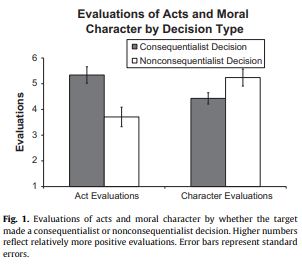] --- # Person-act dissociations .footnote[Tannenbaum, Uhlmann, & Diermeier (2011)] #### Method <center><b>Woman-beater</b></center> >.smaller[John learns that his girlfriend of 8 years has been sleeping around with another man. Upon hearing this, John becomes overwhelmed with rage and beats up .highlight-blue[his girlfriend].] <center><b>Cat-beater</b></center> >.smaller[John learns that his girlfriend of 8 years has been sleeping around with another man. Upon hearing this, John becomes overwhelmed with rage and beats up .highlight-blue[his girlfriend's cat.]] --- # Person-act dissociations .footnote[Tannenbaum, Uhlmann, & Diermeier (2011)] #### Results - Participants rated beating up one's girlfriend as a morally worse *act* than beating up one's girlfriend's cat - Participants rated the cat-beater as having significantly worse *moral character* than the woman-beater -- .dq[.smaller[What do you think harming the cat would be more informative of poor moral character?]] --- # Person-act dissociations .footnote[Uhlmann, Zhu, & Tannenbaum (2013)] #### Explanations - **Empathetic suppression.** Making a consequentialist decision means that you were able to suppress your empathy (and therefore shows a non-functioning cognitive-moral machinery) ??? Psychopaths make utilitarian decisions because they wish to cause harm -- - **Moral-motives problem.** Making the consequentialist decision could be due to wanting to do the right thing, but also, to cause harm, be selfish, etc. -- - **Moral pragmatism**. Acts could be judged pragmatically (not willing to sacrifice for the greater good is unpractical) while character is not --- # Summary - We infer moral traits about others automatically, from as little as their appearance - Behavior can be uninformative if we are trying to understand someone's moral character - Good people do bad things and bad people do good things - Instead, we evaluate one's moral machinery - if they react as they should to moral situations - Sometimes we evaluate people negatively for doing actions that we consider admirable, and positively for doing actions that we consider immoral (called a person-act dissociation) .highlight-blue[Next class:] blame and praise